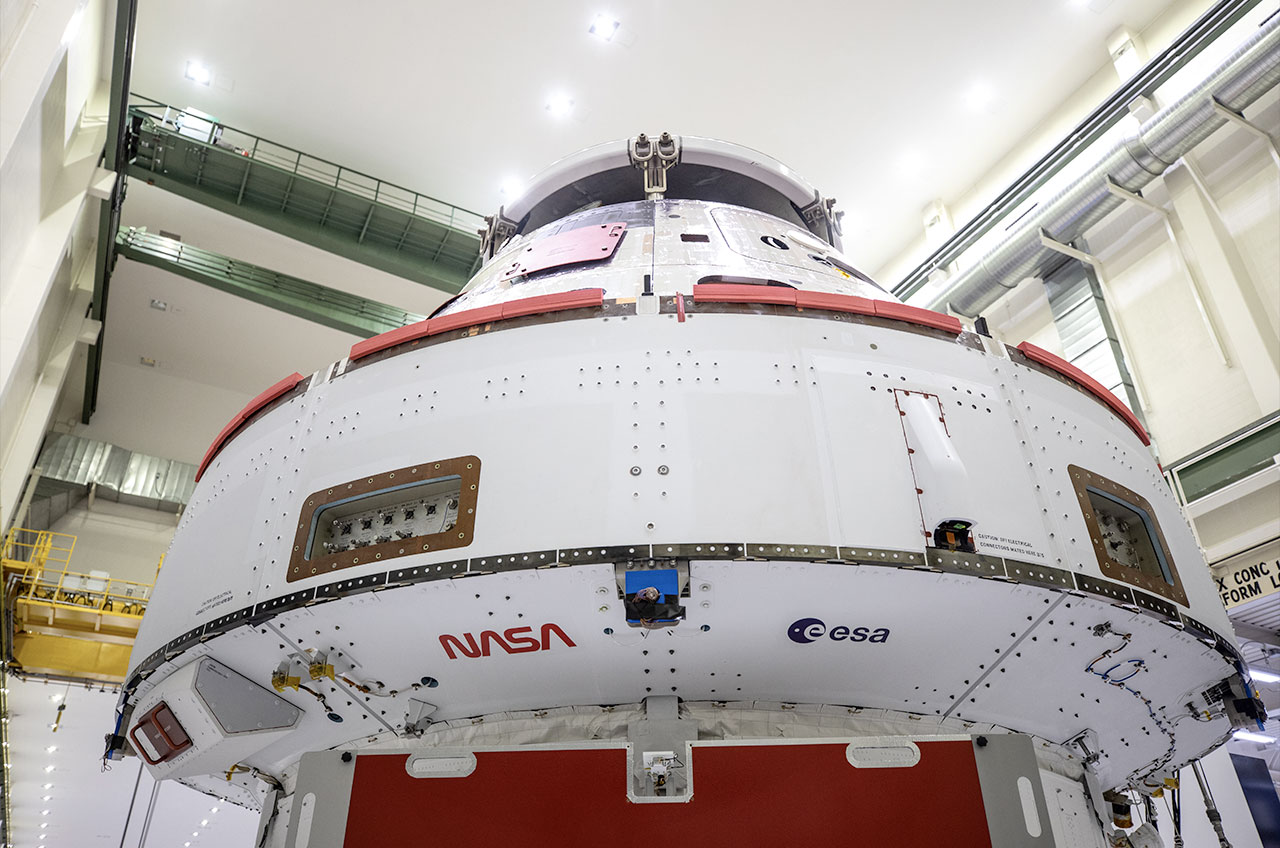NASA reveals retro 'worm' logo painted on moon-bound Artemis rocket
The worm is back, again.
A symbol from NASA's post-Apollo era has found a new ride to the moon.
The space agency's once-retired logotype known as the "worm" has been added to the rocket and spacecraft that will launch NASA's efforts to return astronauts to the lunar surface.
"I'm excited to share the first photos of the NASA worm and ESA [European Space Agency] logo that will be on the Artemis I mission. I am looking forward to seeing the Space Launch System rocket and Orion spacecraft take flight with these iconic symbols," NASA Administrator Jim Bridenstine wrote on Twitter on Wednesday (Sept. 30).
Space Launch System: NASA's next-generation rocket

Designed in 1974, two years after the last Apollo astronauts walked on the moon, the worm served as NASA's official logo through the first decade of the space shuttle program. It was retired in 1992, after NASA decided to re-adopt its original insignia, nicknamed the "meatball."
Linked to a bygone era, the worm gradually gained a retro-cool status, leading to NASA returning the logo to flight earlier this year. The solid red insignia was added to the side of the SpaceX rocket that carried the first astronauts to lift off from a U.S. launchpad after a nine-year hiatus.
"Our famous logotype is back in action, and it is thrilling for all of us that worked on the original design to have it return in such an impressive way." said Richard Danne, who with Bruce Blackburn created the insignia for NASA. "It is particularly exciting to be involved with the Artemis program, so full of potential beginning with this promising first mission."
Breaking space news, the latest updates on rocket launches, skywatching events and more!
The Artemis I mission, targeted for late 2021, will send an Orion spacecraft beyond the moon to evaluate the performance of the Space Launch System (SLS) and assess Orion's ability to support a crew before the capsule begins carrying astronauts.

The worm will fly on Artemis I emblazoned on the two solid rocket boosters that will power the SLS at liftoff through the first two and a half minutes of flight. Workers at NASA's Kennedy Space Center in Florida used a laser projector to mask off the logotype with tape and then painted the worm on one segment for each of the two boosters.
"The most technically challenging task was identifying the correct sizing and location of where the logo was to go," said William Richards, an engineer with Jacobs, the lead contractor for the boosters' stacking operations. "New laser technology helped us lay it out in the correct position to mask off for the painting and correctly shape the letters, especially the curve of the 'S.'"
Later, when the segments are moved into the Vehicle Assembly Building (VAB) for stacking, technicians will secure an access panel across the middle section of the boosters and paint it to finish the insignia.
The worm was also recently added to the Artemis I Orion, along with the ESA logo. The emblems were cut into flight-proof decals and adhered to the underside of the crew module adapter (CMA). ESA is providing the Orion service module, which will carry the fuel and propel the capsule through space.
The NASA and ESA logos will be in view of the cameras mounted to the end of the Orion's solar arrays as the spacecraft travels toward the moon and back.
The decals were added by Frank Pelkey, a technician who previously painted the American flag on the uncrewed Orion that flew on NASA's Exploration Flight Test-1 (EFT-1) in 2014.

"I felt a great sense of pride when painting the U.S. flag on Orion's first flight," said Pelkey. "It was that same feeling of gratitude to be selected to apply the NASA and ESA logos to the vehicle for the first Artemis mission."
Later this year, workers will apply a U.S. flag and the NASA meatball insignia to the Orion crew module, in addition to a decal of the worm on the outer band of the CMA. These logos will also be seen during the mission. The worm on the CMA band will be visible while the vehicle is on the launchpad as well.
Another NASA meatball and the ESA logo will be applied to the fairings that will cover the service module for launch, and an American flag will appear on the SLS Interim Cryogenic Propulsion Stage and on the Orion launch abort system, the latter with the words "United States.”
Click through to collectSPACE to see a time-lapse video of the "worm" logotype being painted and an animation of the Artemis I Space Launch System rocket on the launchpad.
Follow collectSPACE.com on Facebook and on Twitter at @collectSPACE. Copyright 2020 collectSPACE.com. All rights reserved.

Robert Pearlman is a space historian, journalist and the founder and editor of collectSPACE.com, a daily news publication and community devoted to space history with a particular focus on how and where space exploration intersects with pop culture. Pearlman is also a contributing writer for Space.com and co-author of "Space Stations: The Art, Science, and Reality of Working in Space” published by Smithsonian Books in 2018.
In 2009, he was inducted into the U.S. Space Camp Hall of Fame in Huntsville, Alabama. In 2021, he was honored by the American Astronautical Society with the Ordway Award for Sustained Excellence in Spaceflight History. In 2023, the National Space Club Florida Committee recognized Pearlman with the Kolcum News and Communications Award for excellence in telling the space story along the Space Coast and throughout the world.

